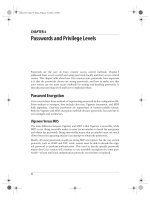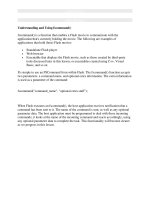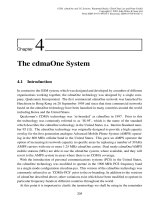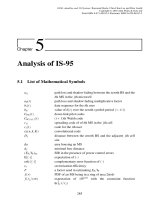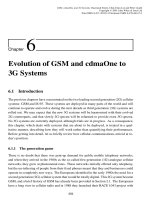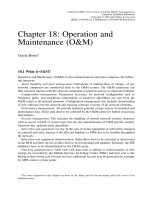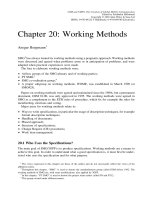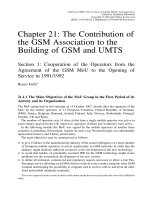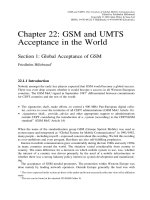Tài liệu GSM and UMTS (P23) pdf
Bạn đang xem bản rút gọn của tài liệu. Xem và tải ngay bản đầy đủ của tài liệu tại đây (25.32 KB, 2 trang )
Chapter 23: GSM’s Success
Factors
Friedhelm Hillebrand
1
23.1 Acceptance in Europe, the First Step
The first big step was the success and acceptance in all European countries. GSM was
certainly the right product at the right time. There were countries like France and Germany
who needed capacity in the early 1990s. Other countries like the UK, Italy, the Nordic
countries had high capacity analogue systems. They were attracted by superior GSM features
like small hand-held terminals as well as superior services like international roaming, SMS
and data services. Also the high security, capacity and quality played an important role. In
addition the newly licensed operators put forward demanding requirements. These demand-
ing market requirements led to an advanced future proof system design and specification and
evolution.
The way all players in Europe worked together towards a common goal and the energy this
created was essential. In this process a capability was developed to reach decisions even on
the most controversial questions, which had not been anticipated.
A key activity to build momentum was the co-ordinated infrastructure procurement by the
operators in 1988 which lead to ten contracts which convinced manufacturers to take GSM
seriously.
2
23.2 Globalisation by World-wide Opening
For the globalisation again the principle ‘‘the right product at the right time’’ was the key. In
the early 1990s GSM existed in many networks. Advanced terminals and infrastructure were
available. International roaming was in operation. This worked together due to the compre-
hensive GSM system standard. There was no real competition in digital systems by other
standards. Therefore the advantages over existing analogue systems became the key for the
countries outside Europe. And GSM was future-proof.
The globalisation of GSM was driven by the fact that the major manufacturers understood
the opportunity to play a leading world market role in mobile communication promoting
GSM. This was spearheaded by Ericsson and Nokia, but all other major manufacturers like
1
The views expressed in this chapter are those of the author and do not necessarily reflect the views of his
affiliation entity.
2
For terminals no co-ordinated procurement had taken place. There was a lack of terminals at service opening.
GSM and UMTS: The Creation of Global Mobile Communication
Edited by Friedhelm Hillebrand
Copyright q 2001 John Wiley & Sons Ltd
ISBNs: 0-470-84322-5 (Hardback); 0-470-845546 (Electronic)
Alcatel, Lucent, Motorola, Nortel and Siemens were active as well. Amongst the operators
Vodafone exploited this potential best. But also France Telecom, Deutsche Telekom, BT,
Sonera and Telenor participated. The promotion was supported by actions of the GSM
Association and associations of manufacturers.
The open welcome and participation offered to the non-European operators was a key
element. The globalisation of the European GSM MoU Group to the world-wide open GSM
Association and the transformation of the European standardisation groups in CEPT via ETSI
to the Third Generation Partnership Project (3GPP) were other key reasons for the global
acceptance of GSM. The very fast evolution of GSM even towards third generation (UMTS)
made GSM/UMTS the most future proof solution world-wide leading to a market share of
69%.
23.3 GSM’s Superior Services and Systems Features, the Basis of the
Success
The ‘‘ right product’’ encompasses in the rapidly evolving markets a very advanced services
and systems concept. GSM offers the most comprehensive range of services: telephony, short
message, data and a very comprehensive range of supplementary services. Above this a
superior set of toolkits for service creation was defined. GSM is the only system allowing
a global roaming to all continents.
GSM offers an unmatched voice quality due to the basic high quality radio transmission
and a range of voice codecs, even with an adaptive system solution offering the optimum
combination of capacity and quality in each cell.
GSM systems offer a very high capacity by employing a very high frequency efficiency by
using an advanced TDMA technology with adaptive power control, strong channel coding
and equalisation, slow frequency hopping and discontinuous transmission, microcells under
the umbrella of macrocells. GSM is very robust due to the mobile assisted handover.
GSM is optimised for hand-helds. Digital technology allows the use of very largescale
integration. The technology is less complex than some competitors. A sleep mode allows
battery saving. Slow frequency hopping ensures a high quality for slowly moving hand-helds.
GSM’s superior security and anti-fraud measures protect the users privacy and the oper-
ator’s revenue. GSM is an open standard, that is not dominated by the IPR of a single
manufacturer. GSM provides the only complete system standard defining services, system
architecture and selected interfaces: SIM/ME, terminal/base station, two intra-network inter-
faces and an inter-network interface enabling international roaming. GSM terminals, infra-
structure and test systems have the highest market volume and the widest number of
manufacturers leading to the widest choice and lowest cost.
GSM and UMTS: The Creation of Global Mobile Communication548
